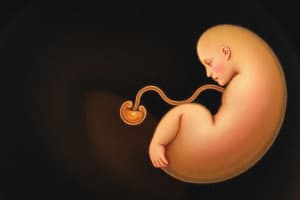Podcast
Questions and Answers
What is the process by which sperm and ovum combine to create a zygote?
What is the process by which sperm and ovum combine to create a zygote?
Fertilization
What causes multiple births?
What causes multiple births?
- Dizygotic twins
- Monozygotic twins
- Both A and B (correct)
- None of the above
What does DNA stand for?
What does DNA stand for?
Deoxyribonucleic acid
What are chromosomes made up of?
What are chromosomes made up of?
Mitosis is the process by which sex cells divide.
Mitosis is the process by which sex cells divide.
What is the Y chromosome responsible for in males?
What is the Y chromosome responsible for in males?
Which alleles are associated with dominant inheritance?
Which alleles are associated with dominant inheritance?
What is polygenic inheritance?
What is polygenic inheritance?
Which of the following is a genetic disorder linked to hemophilia?
Which of the following is a genetic disorder linked to hemophilia?
What does the term 'homozygous' mean?
What does the term 'homozygous' mean?
Match the following genetic disorders with their description:
Match the following genetic disorders with their description:
Study Notes
Fertilization
- Sperm and ovum (sex cells) combine to form a zygote.
Multiple Births
- Dizygotic Twins (Fraternal twins) form from two separate eggs fertilized by two different sperm.
- Monozygotic Twins (Identical twins) form when one fertilized egg splits into two embryos.
Heredity
- The study of genetic transmission of traits from parents to offspring.
DNA
- Deoxyribonucleic acid is a double helix structure resembling a spiraling ladder with chemical units called bases.
Chromosomes
- Coils of DNA containing genes.
Mitosis
- Process of cell division where non-sex cells divide in half.
Mutation
- Permanent alteration in genes or chromosomes, potentially leading to harmful characteristics.
Sex Determination
- At conception, 23 chromosomes from sperm and 23 from ovum combine to form 23 pairs.
- Autosomes: 22 pairs, not related to sexual expression.
- Sex Chromosomes: 23rd pair; one from each parent, either X or Y.
- Y chromosome carries the SRY gene, responsible for maleness.
- XX = Female
- XY = Male
Dominant and Recessive Traits
- Alleles: Different versions of a gene.
- Homozygous: Two identical alleles for a trait.
- Heterozygous: Two different alleles for a trait.
- Dominant Inheritance: Expression of the dominant allele when different alleles are present.
- Recessive Inheritance: Expression of a non-dominant trait when two identical recessive alleles are present.
- Polygenic Inheritance: Multiple genes affecting a complex trait.
Genetic and Chromosomal Abnormalities
- Alpha1 Antitrypsin Deficiency: Enzyme deficiency causing liver and lung issues.
- Alpha Thalassemia: Severe anemia, often fatal.
- Beta Thalassemia (Cooley's Anemia): Severe anemia with symptoms like weakness, fatigue, and frequent illness.
- Cystic Fibrosis: Overproduction of mucus, leading to complications in the lungs and digestive system.
- Duchenne Muscular Dystrophy: Fatal muscular disease primarily affecting males.
- Hemophilia: Excessive bleeding, commonly affecting males.
- Anencephaly: Absence of brain tissue, often fatal.
- Spina Bifida: Incompletely closed spinal canal leading to various complications.
- Phenylketonuria (PKU): Build-up of phenylalanine causing developmental issues.
- Polycystic Kidney Disease: Enlarged kidneys causing various problems.
- Sickle-cell Anemia: Deformed red blood cells leading to oxygen deprivation, pain, and various complications.
- Tay-Sachs Disease: Degenerative disease of the brain, often fatal.
Studying That Suits You
Use AI to generate personalized quizzes and flashcards to suit your learning preferences.
Related Documents
Description
This quiz covers essential topics in biology, including fertilization, genetic inheritance, and the structure of DNA. Explore the differences between dizygotic and monozygotic twins, learn about chromosomes, mitosis, and mutations, as well as how sex is determined in offspring. Test your understanding of these foundational concepts in genetics.




